Business Law: Contract Formation and Australian Constitution
VerifiedAdded on 2023/04/24
|11
|2629
|346
Report
AI Summary
This business law assignment addresses the principles of the Australian Constitution, specifically the doctrine of separation of powers, and applies these principles to a case study involving contract formation. Part A of the assignment outlines the separation of powers into legislative, executive, and judicial branches, explaining their functions and the checks and balances within the Australian system. It highlights the legislative powers of the Parliament, executive powers vested in the Queen and Governor-General, and judicial powers residing in the High Court. Part B provides a memorandum of advice on a hypothetical scenario involving the acquisition of Rigby Corporate Function Planners Pty Ltd by Events Management Ltd. The memorandum analyzes the key elements of a valid contract, including offer, acceptance, consideration, capacity, mutual consent, and legality, and applies these principles to determine if a contract exists between the parties. The assignment employs the ILAC methodology to identify the legal issues, outline relevant law, apply the law to the facts, and reach a conclusion, providing a comprehensive legal analysis of the given scenarios.
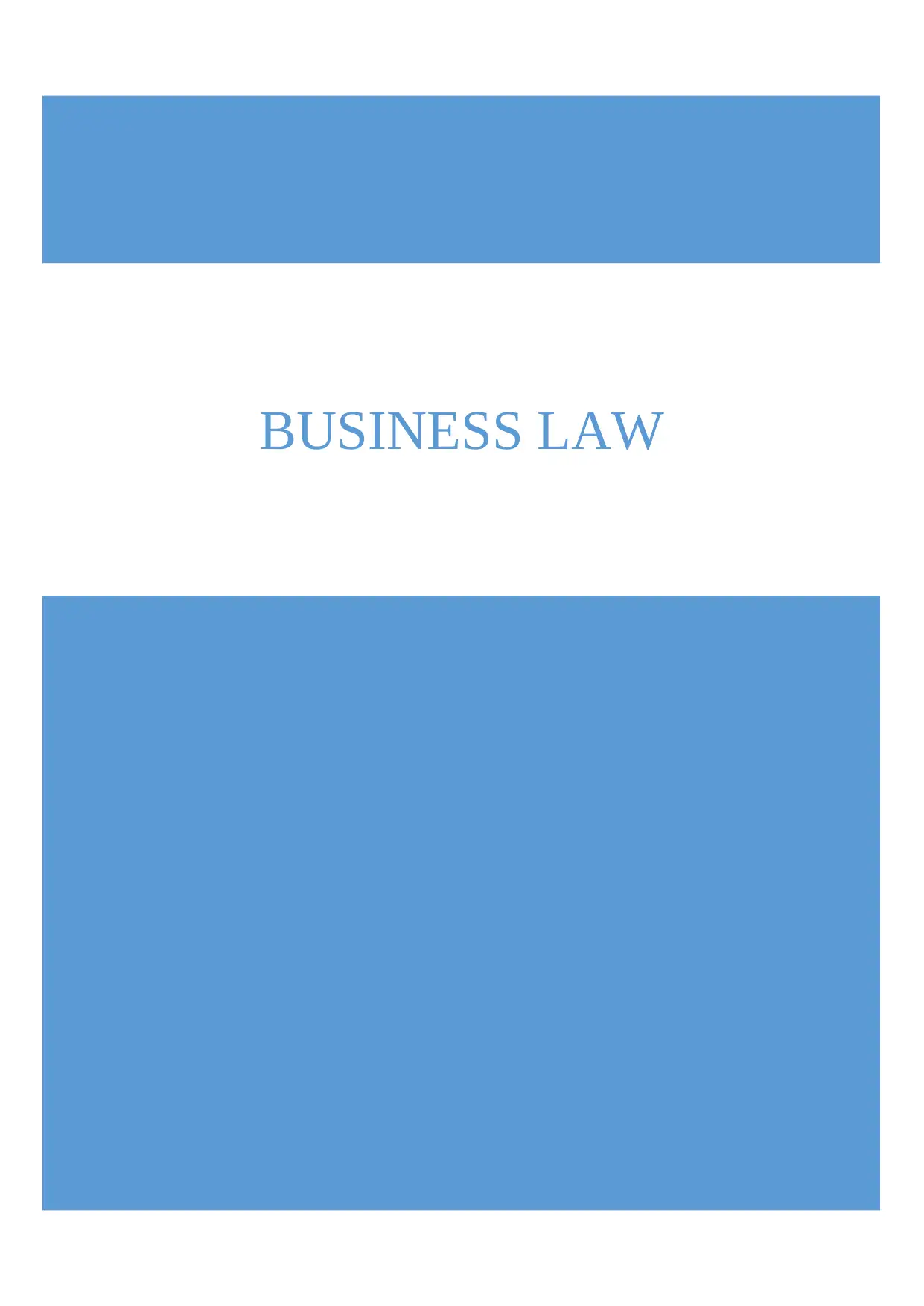
BUSINESS LAW
Paraphrase This Document
Need a fresh take? Get an instant paraphrase of this document with our AI Paraphraser

BUSINESS LAW 1
Contents
PART A......................................................................................................................................1
PART B......................................................................................................................................5
Issue........................................................................................................................................5
Law.........................................................................................................................................5
Application.............................................................................................................................7
Conclusion..............................................................................................................................8
Bibliography...............................................................................................................................9
Case Laws..............................................................................................................................9
Books/Journals.......................................................................................................................9
Other Resources.....................................................................................................................9
PART A
The Doctrine of separation of powers is an essential part of the Constitution of Australia,
whereby the powers of the government are divided into three main categories, namely the
executive, legislative, and judicial powers1. The said doctrine is also referred to as the system
of checks and balances. This is because each of the above listed division is granted its
separate powers, which ought to be checked and must balance the other divisions.
The basic premise behind the establishment of the separation of power is that no single
person or group must be granted large amount of power, so that the same poses a danger
towards the citizens2. Thus, the separation of power is the significant means to reduce the
concentration of powers in a single hand or group. The eventual result of the same is that it
becomes more difficult to abuse the power on part of those who possess the power. As listed
above, there are three main powers of the government and three main divisions of the
1Peo.gov.au, Separation of Powers: Parliament, Executive and Judiciary,
<https://www.peo.gov.au/learning/fact-sheets/separation-of-powers.html>.
2 Civicsacademy.co.za, Separation of Powers, < http://www.civicsacademy.co.za/videos/?category=separation-
of-powers>.
Contents
PART A......................................................................................................................................1
PART B......................................................................................................................................5
Issue........................................................................................................................................5
Law.........................................................................................................................................5
Application.............................................................................................................................7
Conclusion..............................................................................................................................8
Bibliography...............................................................................................................................9
Case Laws..............................................................................................................................9
Books/Journals.......................................................................................................................9
Other Resources.....................................................................................................................9
PART A
The Doctrine of separation of powers is an essential part of the Constitution of Australia,
whereby the powers of the government are divided into three main categories, namely the
executive, legislative, and judicial powers1. The said doctrine is also referred to as the system
of checks and balances. This is because each of the above listed division is granted its
separate powers, which ought to be checked and must balance the other divisions.
The basic premise behind the establishment of the separation of power is that no single
person or group must be granted large amount of power, so that the same poses a danger
towards the citizens2. Thus, the separation of power is the significant means to reduce the
concentration of powers in a single hand or group. The eventual result of the same is that it
becomes more difficult to abuse the power on part of those who possess the power. As listed
above, there are three main powers of the government and three main divisions of the
1Peo.gov.au, Separation of Powers: Parliament, Executive and Judiciary,
<https://www.peo.gov.au/learning/fact-sheets/separation-of-powers.html>.
2 Civicsacademy.co.za, Separation of Powers, < http://www.civicsacademy.co.za/videos/?category=separation-
of-powers>.
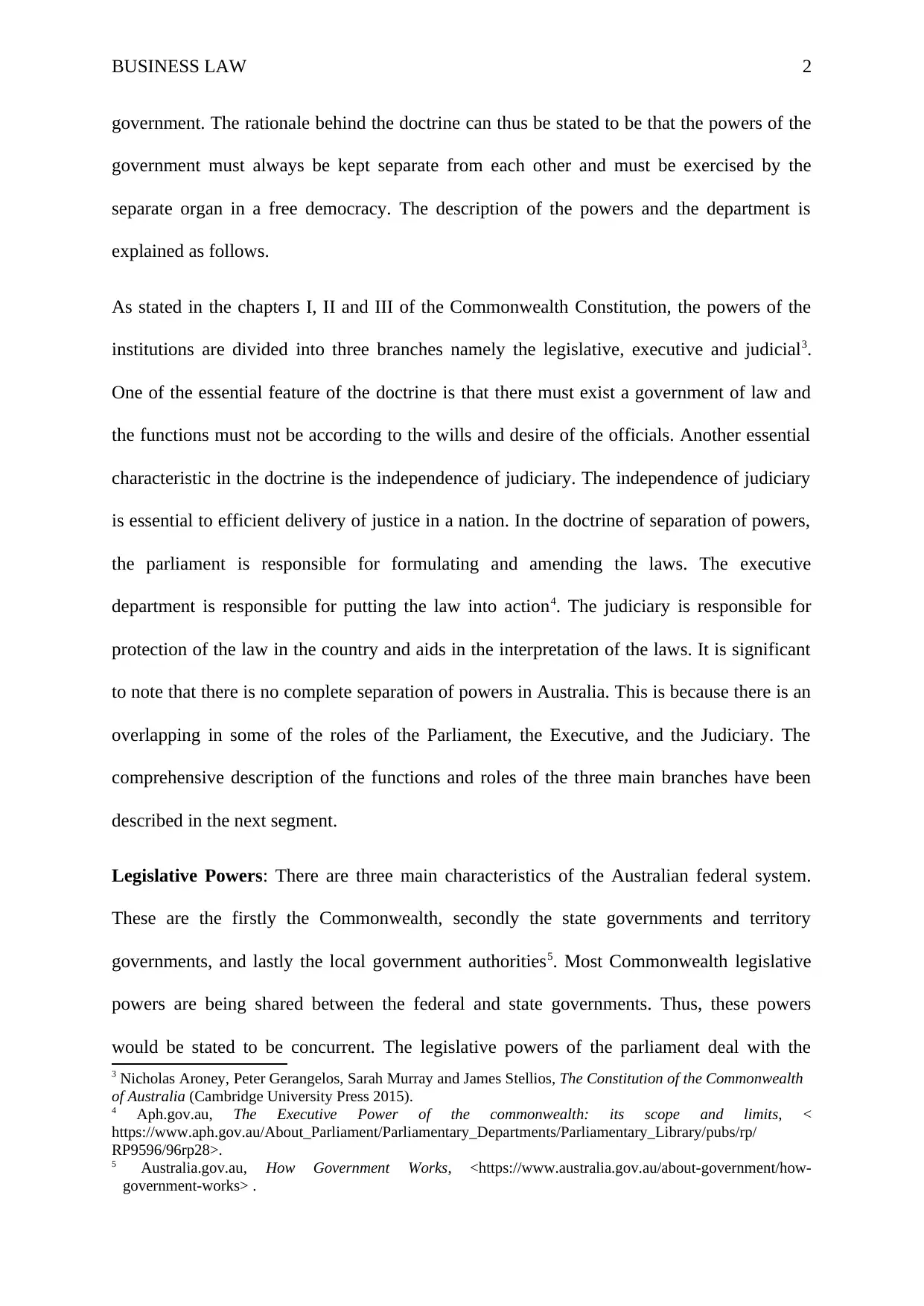
BUSINESS LAW 2
government. The rationale behind the doctrine can thus be stated to be that the powers of the
government must always be kept separate from each other and must be exercised by the
separate organ in a free democracy. The description of the powers and the department is
explained as follows.
As stated in the chapters I, II and III of the Commonwealth Constitution, the powers of the
institutions are divided into three branches namely the legislative, executive and judicial3.
One of the essential feature of the doctrine is that there must exist a government of law and
the functions must not be according to the wills and desire of the officials. Another essential
characteristic in the doctrine is the independence of judiciary. The independence of judiciary
is essential to efficient delivery of justice in a nation. In the doctrine of separation of powers,
the parliament is responsible for formulating and amending the laws. The executive
department is responsible for putting the law into action4. The judiciary is responsible for
protection of the law in the country and aids in the interpretation of the laws. It is significant
to note that there is no complete separation of powers in Australia. This is because there is an
overlapping in some of the roles of the Parliament, the Executive, and the Judiciary. The
comprehensive description of the functions and roles of the three main branches have been
described in the next segment.
Legislative Powers: There are three main characteristics of the Australian federal system.
These are the firstly the Commonwealth, secondly the state governments and territory
governments, and lastly the local government authorities5. Most Commonwealth legislative
powers are being shared between the federal and state governments. Thus, these powers
would be stated to be concurrent. The legislative powers of the parliament deal with the
3 Nicholas Aroney, Peter Gerangelos, Sarah Murray and James Stellios, The Constitution of the Commonwealth
of Australia (Cambridge University Press 2015).
4 Aph.gov.au, The Executive Power of the commonwealth: its scope and limits, <
https://www.aph.gov.au/About_Parliament/Parliamentary_Departments/Parliamentary_Library/pubs/rp/
RP9596/96rp28>.
5 Australia.gov.au, How Government Works, <https://www.australia.gov.au/about-government/how-
government-works> .
government. The rationale behind the doctrine can thus be stated to be that the powers of the
government must always be kept separate from each other and must be exercised by the
separate organ in a free democracy. The description of the powers and the department is
explained as follows.
As stated in the chapters I, II and III of the Commonwealth Constitution, the powers of the
institutions are divided into three branches namely the legislative, executive and judicial3.
One of the essential feature of the doctrine is that there must exist a government of law and
the functions must not be according to the wills and desire of the officials. Another essential
characteristic in the doctrine is the independence of judiciary. The independence of judiciary
is essential to efficient delivery of justice in a nation. In the doctrine of separation of powers,
the parliament is responsible for formulating and amending the laws. The executive
department is responsible for putting the law into action4. The judiciary is responsible for
protection of the law in the country and aids in the interpretation of the laws. It is significant
to note that there is no complete separation of powers in Australia. This is because there is an
overlapping in some of the roles of the Parliament, the Executive, and the Judiciary. The
comprehensive description of the functions and roles of the three main branches have been
described in the next segment.
Legislative Powers: There are three main characteristics of the Australian federal system.
These are the firstly the Commonwealth, secondly the state governments and territory
governments, and lastly the local government authorities5. Most Commonwealth legislative
powers are being shared between the federal and state governments. Thus, these powers
would be stated to be concurrent. The legislative powers of the parliament deal with the
3 Nicholas Aroney, Peter Gerangelos, Sarah Murray and James Stellios, The Constitution of the Commonwealth
of Australia (Cambridge University Press 2015).
4 Aph.gov.au, The Executive Power of the commonwealth: its scope and limits, <
https://www.aph.gov.au/About_Parliament/Parliamentary_Departments/Parliamentary_Library/pubs/rp/
RP9596/96rp28>.
5 Australia.gov.au, How Government Works, <https://www.australia.gov.au/about-government/how-
government-works> .
⊘ This is a preview!⊘
Do you want full access?
Subscribe today to unlock all pages.

Trusted by 1+ million students worldwide
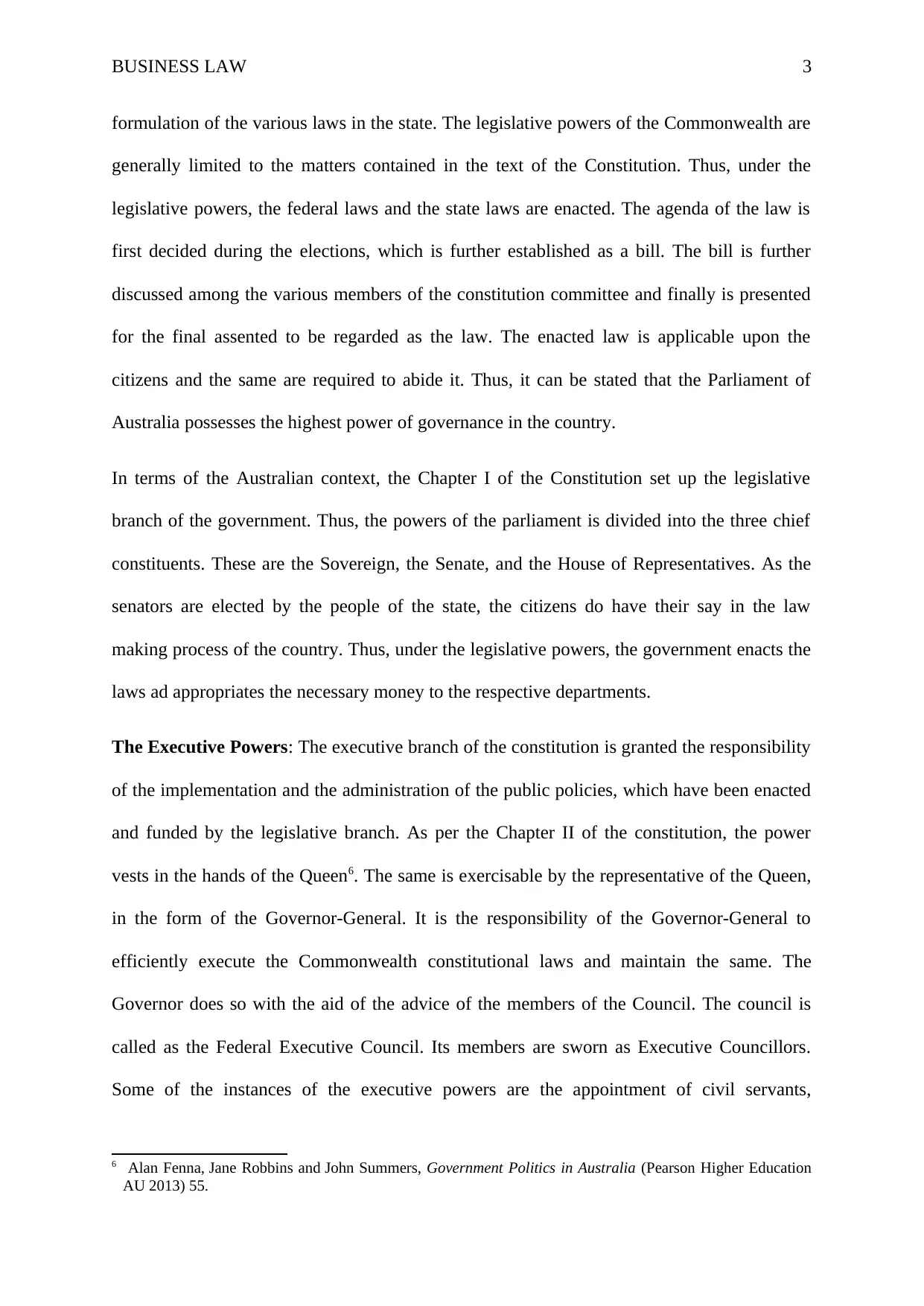
BUSINESS LAW 3
formulation of the various laws in the state. The legislative powers of the Commonwealth are
generally limited to the matters contained in the text of the Constitution. Thus, under the
legislative powers, the federal laws and the state laws are enacted. The agenda of the law is
first decided during the elections, which is further established as a bill. The bill is further
discussed among the various members of the constitution committee and finally is presented
for the final assented to be regarded as the law. The enacted law is applicable upon the
citizens and the same are required to abide it. Thus, it can be stated that the Parliament of
Australia possesses the highest power of governance in the country.
In terms of the Australian context, the Chapter I of the Constitution set up the legislative
branch of the government. Thus, the powers of the parliament is divided into the three chief
constituents. These are the Sovereign, the Senate, and the House of Representatives. As the
senators are elected by the people of the state, the citizens do have their say in the law
making process of the country. Thus, under the legislative powers, the government enacts the
laws ad appropriates the necessary money to the respective departments.
The Executive Powers: The executive branch of the constitution is granted the responsibility
of the implementation and the administration of the public policies, which have been enacted
and funded by the legislative branch. As per the Chapter II of the constitution, the power
vests in the hands of the Queen6. The same is exercisable by the representative of the Queen,
in the form of the Governor-General. It is the responsibility of the Governor-General to
efficiently execute the Commonwealth constitutional laws and maintain the same. The
Governor does so with the aid of the advice of the members of the Council. The council is
called as the Federal Executive Council. Its members are sworn as Executive Councillors.
Some of the instances of the executive powers are the appointment of civil servants,
6 Alan Fenna, Jane Robbins and John Summers, Government Politics in Australia (Pearson Higher Education
AU 2013) 55.
formulation of the various laws in the state. The legislative powers of the Commonwealth are
generally limited to the matters contained in the text of the Constitution. Thus, under the
legislative powers, the federal laws and the state laws are enacted. The agenda of the law is
first decided during the elections, which is further established as a bill. The bill is further
discussed among the various members of the constitution committee and finally is presented
for the final assented to be regarded as the law. The enacted law is applicable upon the
citizens and the same are required to abide it. Thus, it can be stated that the Parliament of
Australia possesses the highest power of governance in the country.
In terms of the Australian context, the Chapter I of the Constitution set up the legislative
branch of the government. Thus, the powers of the parliament is divided into the three chief
constituents. These are the Sovereign, the Senate, and the House of Representatives. As the
senators are elected by the people of the state, the citizens do have their say in the law
making process of the country. Thus, under the legislative powers, the government enacts the
laws ad appropriates the necessary money to the respective departments.
The Executive Powers: The executive branch of the constitution is granted the responsibility
of the implementation and the administration of the public policies, which have been enacted
and funded by the legislative branch. As per the Chapter II of the constitution, the power
vests in the hands of the Queen6. The same is exercisable by the representative of the Queen,
in the form of the Governor-General. It is the responsibility of the Governor-General to
efficiently execute the Commonwealth constitutional laws and maintain the same. The
Governor does so with the aid of the advice of the members of the Council. The council is
called as the Federal Executive Council. Its members are sworn as Executive Councillors.
Some of the instances of the executive powers are the appointment of civil servants,
6 Alan Fenna, Jane Robbins and John Summers, Government Politics in Australia (Pearson Higher Education
AU 2013) 55.
Paraphrase This Document
Need a fresh take? Get an instant paraphrase of this document with our AI Paraphraser
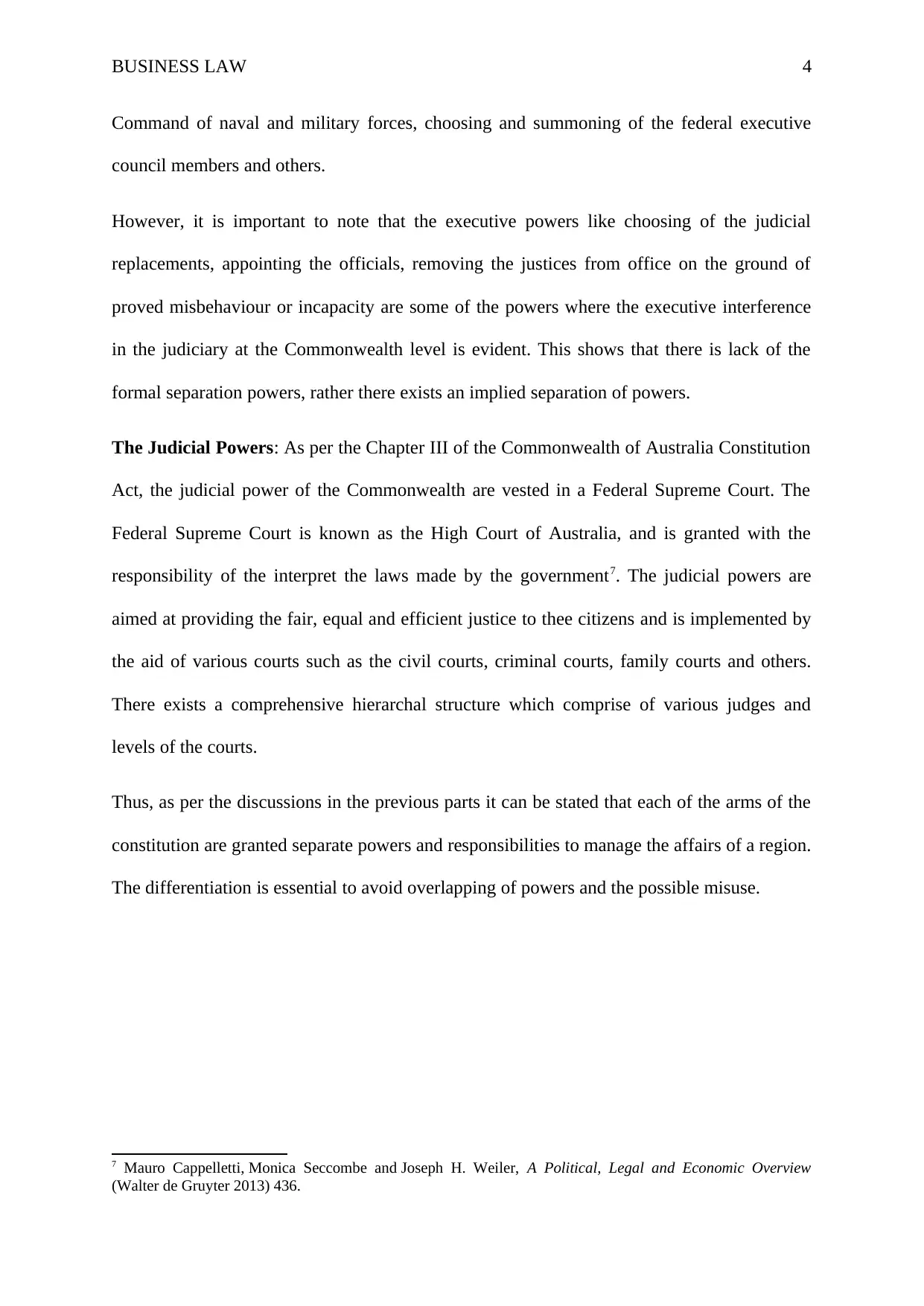
BUSINESS LAW 4
Command of naval and military forces, choosing and summoning of the federal executive
council members and others.
However, it is important to note that the executive powers like choosing of the judicial
replacements, appointing the officials, removing the justices from office on the ground of
proved misbehaviour or incapacity are some of the powers where the executive interference
in the judiciary at the Commonwealth level is evident. This shows that there is lack of the
formal separation powers, rather there exists an implied separation of powers.
The Judicial Powers: As per the Chapter III of the Commonwealth of Australia Constitution
Act, the judicial power of the Commonwealth are vested in a Federal Supreme Court. The
Federal Supreme Court is known as the High Court of Australia, and is granted with the
responsibility of the interpret the laws made by the government7. The judicial powers are
aimed at providing the fair, equal and efficient justice to thee citizens and is implemented by
the aid of various courts such as the civil courts, criminal courts, family courts and others.
There exists a comprehensive hierarchal structure which comprise of various judges and
levels of the courts.
Thus, as per the discussions in the previous parts it can be stated that each of the arms of the
constitution are granted separate powers and responsibilities to manage the affairs of a region.
The differentiation is essential to avoid overlapping of powers and the possible misuse.
7 Mauro Cappelletti, Monica Seccombe and Joseph H. Weiler, A Political, Legal and Economic Overview
(Walter de Gruyter 2013) 436.
Command of naval and military forces, choosing and summoning of the federal executive
council members and others.
However, it is important to note that the executive powers like choosing of the judicial
replacements, appointing the officials, removing the justices from office on the ground of
proved misbehaviour or incapacity are some of the powers where the executive interference
in the judiciary at the Commonwealth level is evident. This shows that there is lack of the
formal separation powers, rather there exists an implied separation of powers.
The Judicial Powers: As per the Chapter III of the Commonwealth of Australia Constitution
Act, the judicial power of the Commonwealth are vested in a Federal Supreme Court. The
Federal Supreme Court is known as the High Court of Australia, and is granted with the
responsibility of the interpret the laws made by the government7. The judicial powers are
aimed at providing the fair, equal and efficient justice to thee citizens and is implemented by
the aid of various courts such as the civil courts, criminal courts, family courts and others.
There exists a comprehensive hierarchal structure which comprise of various judges and
levels of the courts.
Thus, as per the discussions in the previous parts it can be stated that each of the arms of the
constitution are granted separate powers and responsibilities to manage the affairs of a region.
The differentiation is essential to avoid overlapping of powers and the possible misuse.
7 Mauro Cappelletti, Monica Seccombe and Joseph H. Weiler, A Political, Legal and Economic Overview
(Walter de Gruyter 2013) 436.
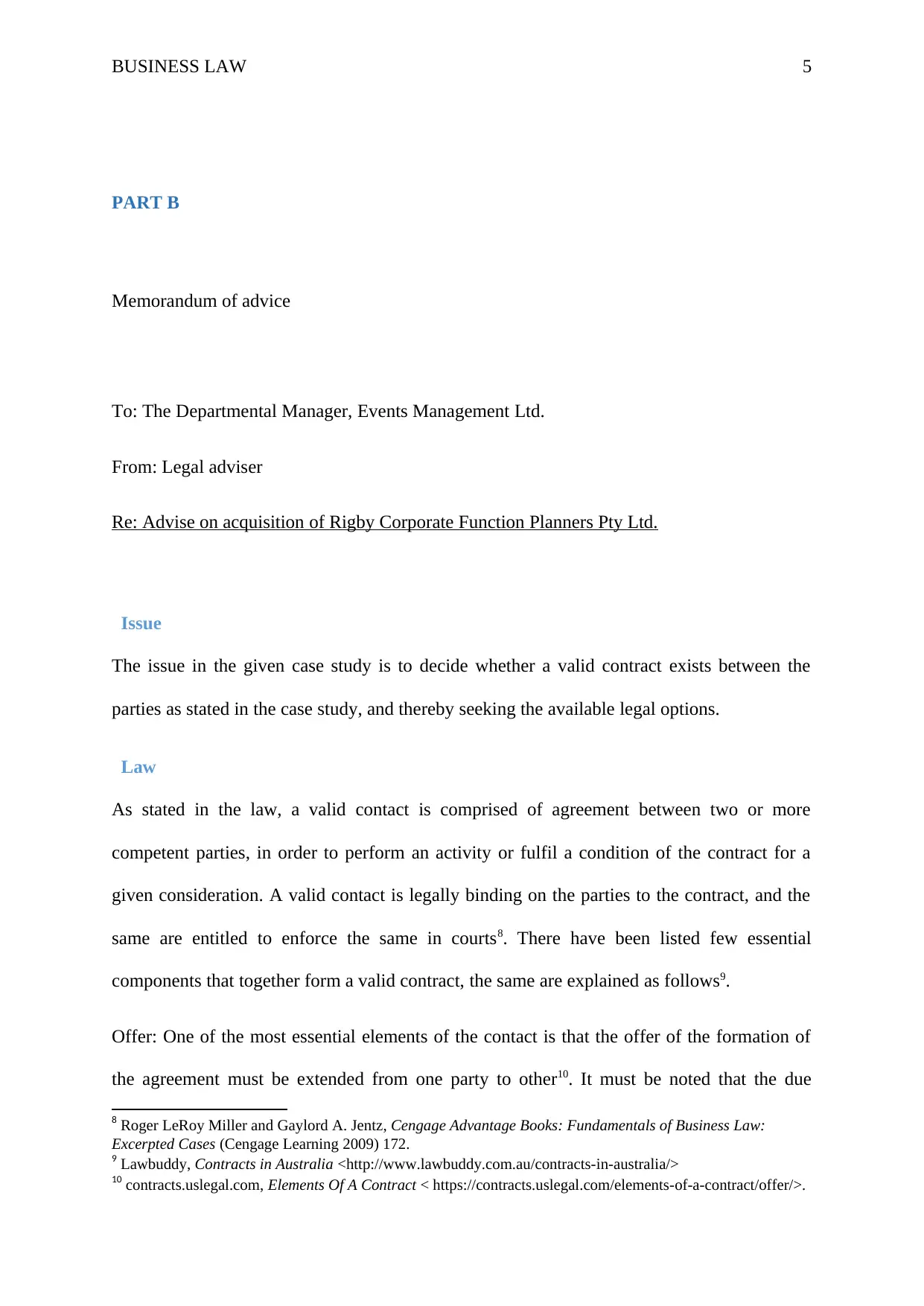
BUSINESS LAW 5
PART B
Memorandum of advice
To: The Departmental Manager, Events Management Ltd.
From: Legal adviser
Re: Advise on acquisition of Rigby Corporate Function Planners Pty Ltd.
Issue
The issue in the given case study is to decide whether a valid contract exists between the
parties as stated in the case study, and thereby seeking the available legal options.
Law
As stated in the law, a valid contact is comprised of agreement between two or more
competent parties, in order to perform an activity or fulfil a condition of the contract for a
given consideration. A valid contact is legally binding on the parties to the contract, and the
same are entitled to enforce the same in courts8. There have been listed few essential
components that together form a valid contract, the same are explained as follows9.
Offer: One of the most essential elements of the contact is that the offer of the formation of
the agreement must be extended from one party to other10. It must be noted that the due
8 Roger LeRoy Miller and Gaylord A. Jentz, Cengage Advantage Books: Fundamentals of Business Law:
Excerpted Cases (Cengage Learning 2009) 172.
9 Lawbuddy, Contracts in Australia <http://www.lawbuddy.com.au/contracts-in-australia/>
10 contracts.uslegal.com, Elements Of A Contract < https://contracts.uslegal.com/elements-of-a-contract/offer/>.
PART B
Memorandum of advice
To: The Departmental Manager, Events Management Ltd.
From: Legal adviser
Re: Advise on acquisition of Rigby Corporate Function Planners Pty Ltd.
Issue
The issue in the given case study is to decide whether a valid contract exists between the
parties as stated in the case study, and thereby seeking the available legal options.
Law
As stated in the law, a valid contact is comprised of agreement between two or more
competent parties, in order to perform an activity or fulfil a condition of the contract for a
given consideration. A valid contact is legally binding on the parties to the contract, and the
same are entitled to enforce the same in courts8. There have been listed few essential
components that together form a valid contract, the same are explained as follows9.
Offer: One of the most essential elements of the contact is that the offer of the formation of
the agreement must be extended from one party to other10. It must be noted that the due
8 Roger LeRoy Miller and Gaylord A. Jentz, Cengage Advantage Books: Fundamentals of Business Law:
Excerpted Cases (Cengage Learning 2009) 172.
9 Lawbuddy, Contracts in Australia <http://www.lawbuddy.com.au/contracts-in-australia/>
10 contracts.uslegal.com, Elements Of A Contract < https://contracts.uslegal.com/elements-of-a-contract/offer/>.
⊘ This is a preview!⊘
Do you want full access?
Subscribe today to unlock all pages.

Trusted by 1+ million students worldwide
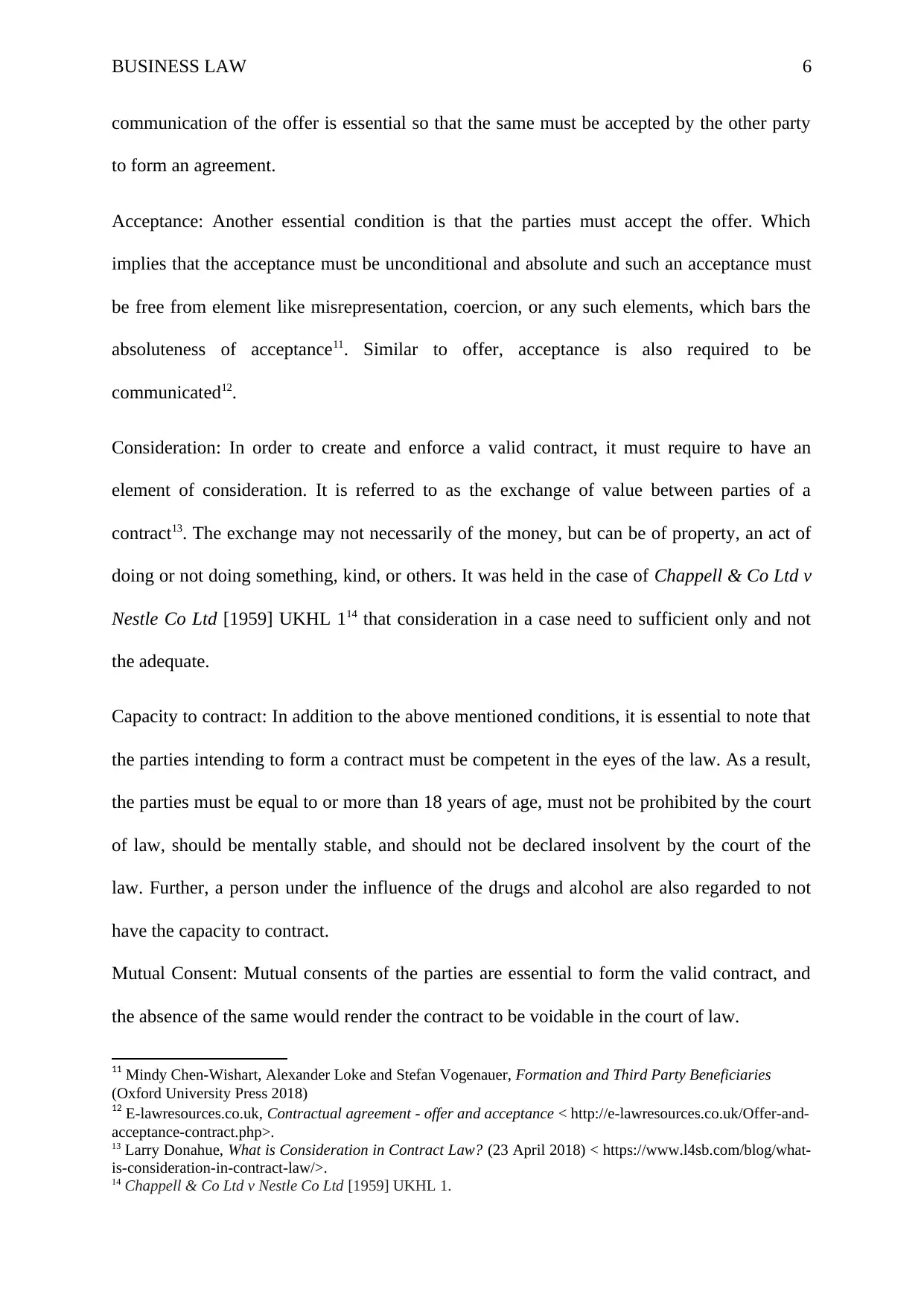
BUSINESS LAW 6
communication of the offer is essential so that the same must be accepted by the other party
to form an agreement.
Acceptance: Another essential condition is that the parties must accept the offer. Which
implies that the acceptance must be unconditional and absolute and such an acceptance must
be free from element like misrepresentation, coercion, or any such elements, which bars the
absoluteness of acceptance11. Similar to offer, acceptance is also required to be
communicated12.
Consideration: In order to create and enforce a valid contract, it must require to have an
element of consideration. It is referred to as the exchange of value between parties of a
contract13. The exchange may not necessarily of the money, but can be of property, an act of
doing or not doing something, kind, or others. It was held in the case of Chappell & Co Ltd v
Nestle Co Ltd [1959] UKHL 114 that consideration in a case need to sufficient only and not
the adequate.
Capacity to contract: In addition to the above mentioned conditions, it is essential to note that
the parties intending to form a contract must be competent in the eyes of the law. As a result,
the parties must be equal to or more than 18 years of age, must not be prohibited by the court
of law, should be mentally stable, and should not be declared insolvent by the court of the
law. Further, a person under the influence of the drugs and alcohol are also regarded to not
have the capacity to contract.
Mutual Consent: Mutual consents of the parties are essential to form the valid contract, and
the absence of the same would render the contract to be voidable in the court of law.
11 Mindy Chen-Wishart, Alexander Loke and Stefan Vogenauer, Formation and Third Party Beneficiaries
(Oxford University Press 2018)
12 E-lawresources.co.uk, Contractual agreement - offer and acceptance < http://e-lawresources.co.uk/Offer-and-
acceptance-contract.php>.
13 Larry Donahue, What is Consideration in Contract Law? (23 April 2018) < https://www.l4sb.com/blog/what-
is-consideration-in-contract-law/>.
14 Chappell & Co Ltd v Nestle Co Ltd [1959] UKHL 1.
communication of the offer is essential so that the same must be accepted by the other party
to form an agreement.
Acceptance: Another essential condition is that the parties must accept the offer. Which
implies that the acceptance must be unconditional and absolute and such an acceptance must
be free from element like misrepresentation, coercion, or any such elements, which bars the
absoluteness of acceptance11. Similar to offer, acceptance is also required to be
communicated12.
Consideration: In order to create and enforce a valid contract, it must require to have an
element of consideration. It is referred to as the exchange of value between parties of a
contract13. The exchange may not necessarily of the money, but can be of property, an act of
doing or not doing something, kind, or others. It was held in the case of Chappell & Co Ltd v
Nestle Co Ltd [1959] UKHL 114 that consideration in a case need to sufficient only and not
the adequate.
Capacity to contract: In addition to the above mentioned conditions, it is essential to note that
the parties intending to form a contract must be competent in the eyes of the law. As a result,
the parties must be equal to or more than 18 years of age, must not be prohibited by the court
of law, should be mentally stable, and should not be declared insolvent by the court of the
law. Further, a person under the influence of the drugs and alcohol are also regarded to not
have the capacity to contract.
Mutual Consent: Mutual consents of the parties are essential to form the valid contract, and
the absence of the same would render the contract to be voidable in the court of law.
11 Mindy Chen-Wishart, Alexander Loke and Stefan Vogenauer, Formation and Third Party Beneficiaries
(Oxford University Press 2018)
12 E-lawresources.co.uk, Contractual agreement - offer and acceptance < http://e-lawresources.co.uk/Offer-and-
acceptance-contract.php>.
13 Larry Donahue, What is Consideration in Contract Law? (23 April 2018) < https://www.l4sb.com/blog/what-
is-consideration-in-contract-law/>.
14 Chappell & Co Ltd v Nestle Co Ltd [1959] UKHL 1.
Paraphrase This Document
Need a fresh take? Get an instant paraphrase of this document with our AI Paraphraser
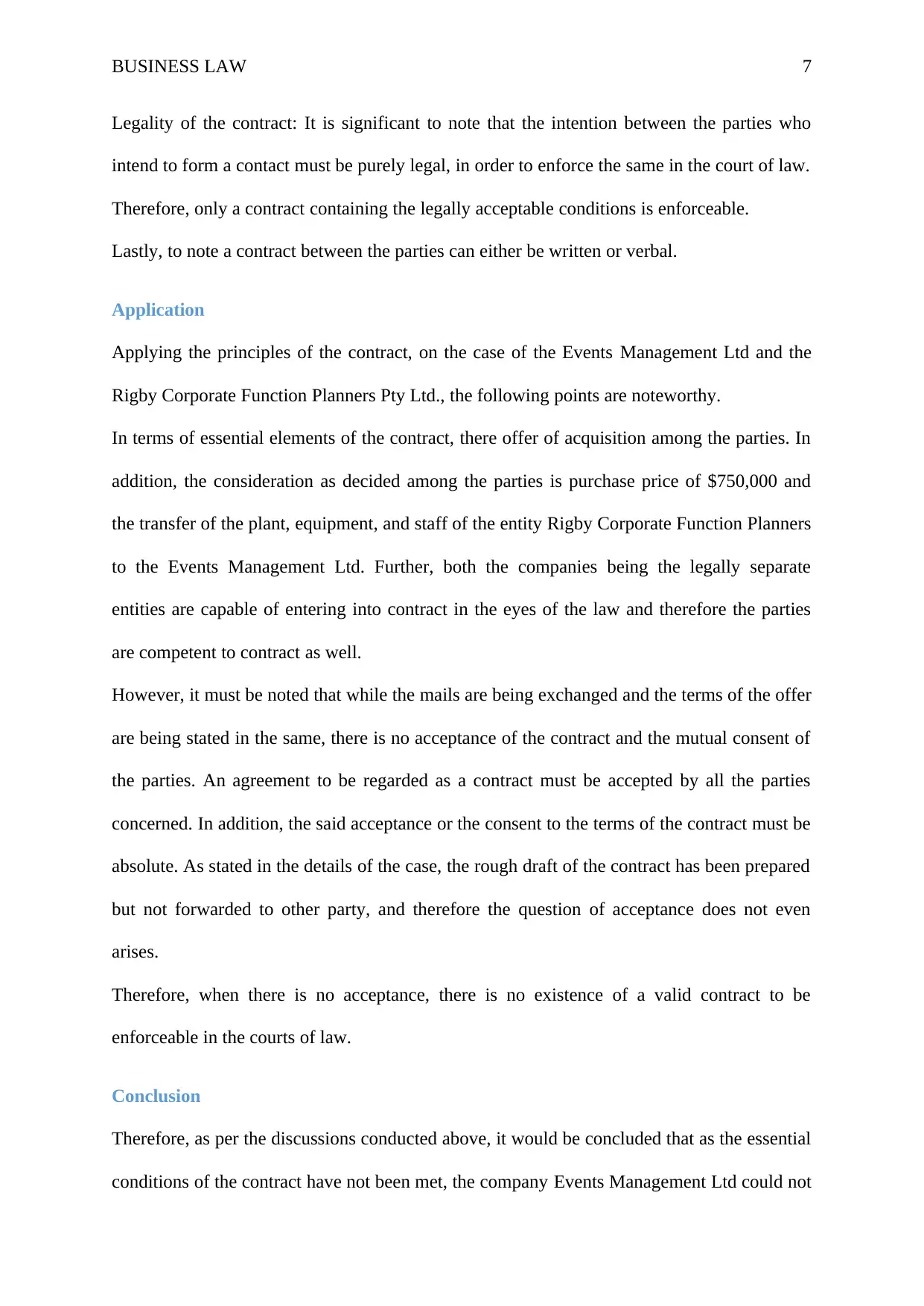
BUSINESS LAW 7
Legality of the contract: It is significant to note that the intention between the parties who
intend to form a contact must be purely legal, in order to enforce the same in the court of law.
Therefore, only a contract containing the legally acceptable conditions is enforceable.
Lastly, to note a contract between the parties can either be written or verbal.
Application
Applying the principles of the contract, on the case of the Events Management Ltd and the
Rigby Corporate Function Planners Pty Ltd., the following points are noteworthy.
In terms of essential elements of the contract, there offer of acquisition among the parties. In
addition, the consideration as decided among the parties is purchase price of $750,000 and
the transfer of the plant, equipment, and staff of the entity Rigby Corporate Function Planners
to the Events Management Ltd. Further, both the companies being the legally separate
entities are capable of entering into contract in the eyes of the law and therefore the parties
are competent to contract as well.
However, it must be noted that while the mails are being exchanged and the terms of the offer
are being stated in the same, there is no acceptance of the contract and the mutual consent of
the parties. An agreement to be regarded as a contract must be accepted by all the parties
concerned. In addition, the said acceptance or the consent to the terms of the contract must be
absolute. As stated in the details of the case, the rough draft of the contract has been prepared
but not forwarded to other party, and therefore the question of acceptance does not even
arises.
Therefore, when there is no acceptance, there is no existence of a valid contract to be
enforceable in the courts of law.
Conclusion
Therefore, as per the discussions conducted above, it would be concluded that as the essential
conditions of the contract have not been met, the company Events Management Ltd could not
Legality of the contract: It is significant to note that the intention between the parties who
intend to form a contact must be purely legal, in order to enforce the same in the court of law.
Therefore, only a contract containing the legally acceptable conditions is enforceable.
Lastly, to note a contract between the parties can either be written or verbal.
Application
Applying the principles of the contract, on the case of the Events Management Ltd and the
Rigby Corporate Function Planners Pty Ltd., the following points are noteworthy.
In terms of essential elements of the contract, there offer of acquisition among the parties. In
addition, the consideration as decided among the parties is purchase price of $750,000 and
the transfer of the plant, equipment, and staff of the entity Rigby Corporate Function Planners
to the Events Management Ltd. Further, both the companies being the legally separate
entities are capable of entering into contract in the eyes of the law and therefore the parties
are competent to contract as well.
However, it must be noted that while the mails are being exchanged and the terms of the offer
are being stated in the same, there is no acceptance of the contract and the mutual consent of
the parties. An agreement to be regarded as a contract must be accepted by all the parties
concerned. In addition, the said acceptance or the consent to the terms of the contract must be
absolute. As stated in the details of the case, the rough draft of the contract has been prepared
but not forwarded to other party, and therefore the question of acceptance does not even
arises.
Therefore, when there is no acceptance, there is no existence of a valid contract to be
enforceable in the courts of law.
Conclusion
Therefore, as per the discussions conducted above, it would be concluded that as the essential
conditions of the contract have not been met, the company Events Management Ltd could not

BUSINESS LAW 8
force the conclusion of the sale. Thus, the company stands no legal options against the Rigby
Corporate Function Planners.
force the conclusion of the sale. Thus, the company stands no legal options against the Rigby
Corporate Function Planners.
⊘ This is a preview!⊘
Do you want full access?
Subscribe today to unlock all pages.

Trusted by 1+ million students worldwide

BUSINESS LAW 9
Bibliography
Case Laws
Chappell & Co Ltd v Nestle Co Ltd [1959] UKHL 1
Books/Journals
Aroney Nicholas, Peter Gerangelos, Sarah Murray and James Stellios, The Constitution of the
Commonwealth of Australia (Cambridge University Press 2015).
Cappelletti Mauro, Monica Seccombe and Joseph H. Weiler, A Political, Legal and
Economic Overview (Walter de Gruyter 2013).
Chen-Wishart Mindy, Alexander Loke and Stefan Vogenauer, Formation and Third Party
Beneficiaries (Oxford University Press 2018)
Fenna Alan, Jane Robbins and John Summers, Government Politics in Australia (Pearson
Higher Education AU 2013).
Miller Roger LeRoy and Gaylord A. Jentz, Cengage Advantage Books: Fundamentals of
Business Law: Excerpted Cases (Cengage Learning 2009)
Other Resources
Aph.gov.au, The Executive Power of the commonwealth: its scope and limits, <
https://www.aph.gov.au/About_Parliament/Parliamentary_Departments/
Parliamentary_Library/pubs/rp/RP9596/96rp28>
Bibliography
Case Laws
Chappell & Co Ltd v Nestle Co Ltd [1959] UKHL 1
Books/Journals
Aroney Nicholas, Peter Gerangelos, Sarah Murray and James Stellios, The Constitution of the
Commonwealth of Australia (Cambridge University Press 2015).
Cappelletti Mauro, Monica Seccombe and Joseph H. Weiler, A Political, Legal and
Economic Overview (Walter de Gruyter 2013).
Chen-Wishart Mindy, Alexander Loke and Stefan Vogenauer, Formation and Third Party
Beneficiaries (Oxford University Press 2018)
Fenna Alan, Jane Robbins and John Summers, Government Politics in Australia (Pearson
Higher Education AU 2013).
Miller Roger LeRoy and Gaylord A. Jentz, Cengage Advantage Books: Fundamentals of
Business Law: Excerpted Cases (Cengage Learning 2009)
Other Resources
Aph.gov.au, The Executive Power of the commonwealth: its scope and limits, <
https://www.aph.gov.au/About_Parliament/Parliamentary_Departments/
Parliamentary_Library/pubs/rp/RP9596/96rp28>
Paraphrase This Document
Need a fresh take? Get an instant paraphrase of this document with our AI Paraphraser
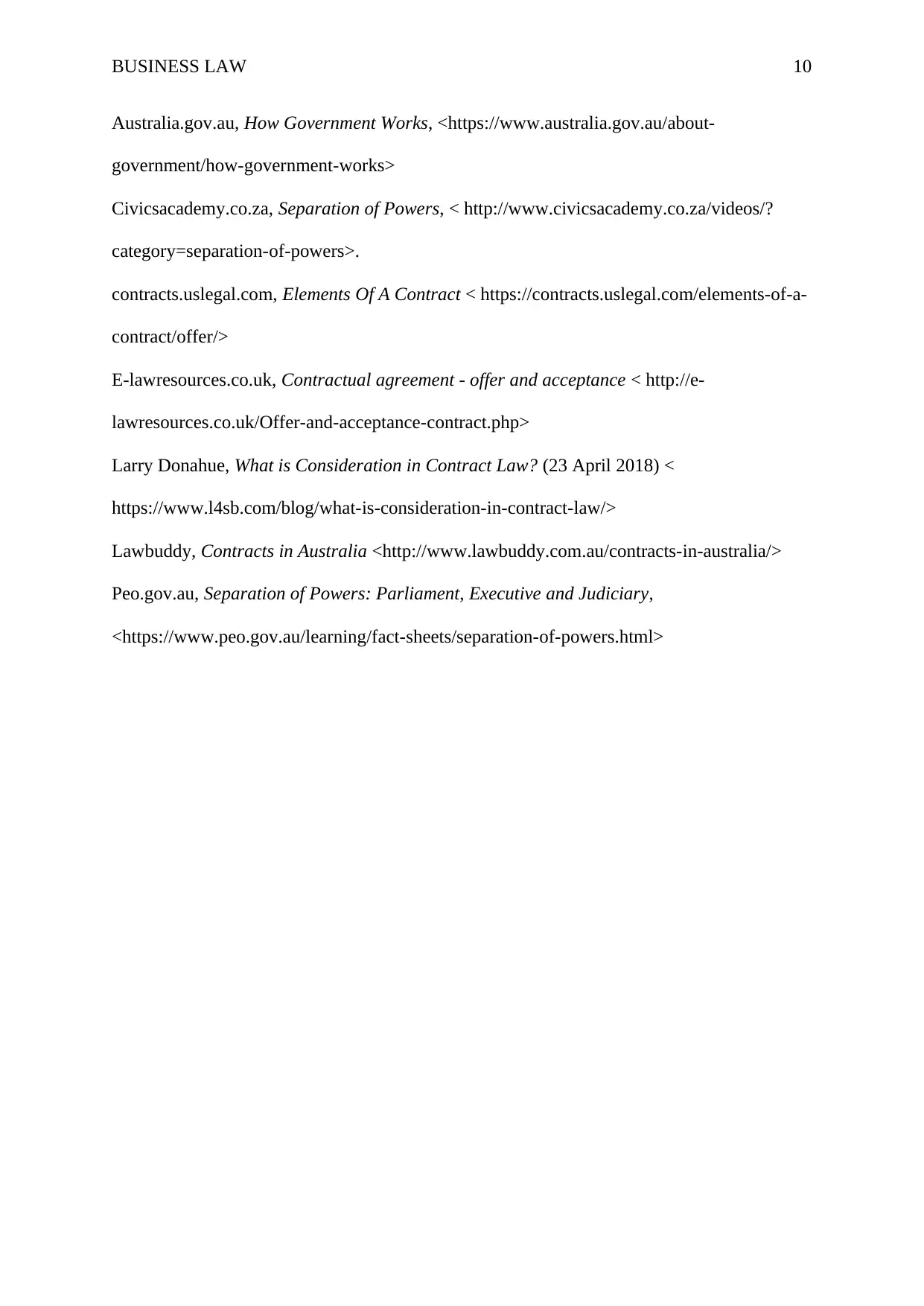
BUSINESS LAW 10
Australia.gov.au, How Government Works, <https://www.australia.gov.au/about-
government/how-government-works>
Civicsacademy.co.za, Separation of Powers, < http://www.civicsacademy.co.za/videos/?
category=separation-of-powers>.
contracts.uslegal.com, Elements Of A Contract < https://contracts.uslegal.com/elements-of-a-
contract/offer/>
E-lawresources.co.uk, Contractual agreement - offer and acceptance < http://e-
lawresources.co.uk/Offer-and-acceptance-contract.php>
Larry Donahue, What is Consideration in Contract Law? (23 April 2018) <
https://www.l4sb.com/blog/what-is-consideration-in-contract-law/>
Lawbuddy, Contracts in Australia <http://www.lawbuddy.com.au/contracts-in-australia/>
Peo.gov.au, Separation of Powers: Parliament, Executive and Judiciary,
<https://www.peo.gov.au/learning/fact-sheets/separation-of-powers.html>
Australia.gov.au, How Government Works, <https://www.australia.gov.au/about-
government/how-government-works>
Civicsacademy.co.za, Separation of Powers, < http://www.civicsacademy.co.za/videos/?
category=separation-of-powers>.
contracts.uslegal.com, Elements Of A Contract < https://contracts.uslegal.com/elements-of-a-
contract/offer/>
E-lawresources.co.uk, Contractual agreement - offer and acceptance < http://e-
lawresources.co.uk/Offer-and-acceptance-contract.php>
Larry Donahue, What is Consideration in Contract Law? (23 April 2018) <
https://www.l4sb.com/blog/what-is-consideration-in-contract-law/>
Lawbuddy, Contracts in Australia <http://www.lawbuddy.com.au/contracts-in-australia/>
Peo.gov.au, Separation of Powers: Parliament, Executive and Judiciary,
<https://www.peo.gov.au/learning/fact-sheets/separation-of-powers.html>
1 out of 11
Related Documents
Your All-in-One AI-Powered Toolkit for Academic Success.
+13062052269
info@desklib.com
Available 24*7 on WhatsApp / Email
![[object Object]](/_next/static/media/star-bottom.7253800d.svg)
Unlock your academic potential
Copyright © 2020–2025 A2Z Services. All Rights Reserved. Developed and managed by ZUCOL.





